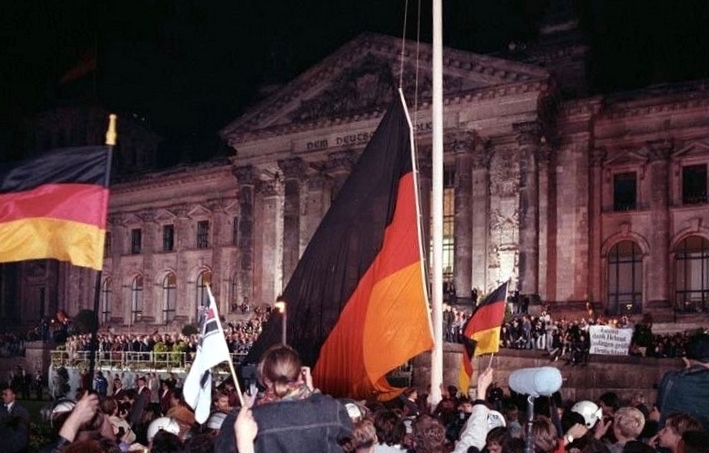
German Federal Archives via Wikimedia Commons
Great Expectations: Germany, America, and the Fall of the Berlin Wall Thirty Years Later

Stephen F. Szabo
Senior Fellow
Dr. Stephen F. Szabo is a Senior Fellow at AICGS, where he focuses on German foreign and security policies and the new German role in Europe and beyond. Until 2017, he was the Executive Director of the Transatlantic Academy, a Washington, DC, based forum for research and dialogue between scholars, policy experts, and authors from both sides of the Atlantic. Prior to joining the German Marshall Fund in 2007, Dr. Szabo was Interim Dean and Associate Dean for Academic Affairs and taught European Studies at The Paul H. Nitze School of Advanced International Studies, Johns Hopkins University. He served as Professor of National Security Affairs at the National War College, National Defense University (1982-1990). He received his PhD in Political Science from Georgetown University and has been a fellow with the Alexander von Humboldt Stiftung, the Woodrow Wilson International Center for Scholars, and the American Academy in Berlin, as well as serving as Research Director at AICGS. In addition to SAIS, he has taught at the Hertie School of Governance, Georgetown University, George Washington University, and the University of Virginia. He has published widely on European and German politics and foreign policies, including. The Successor Generation: International Perspectives of Postwar Europeans, The Diplomacy of German Unification, Parting Ways: The Crisis in the German-American Relationship, and Germany, Russia and the Rise of Geo-Economics.
As Germany commemorates the thirtieth anniversary of the fall of the Berlin Wall, a look back to 1989 and the expectations that surrounded that momentous event reveals some that were met as well as some major disappointments. Was the revolution in East Germany about democracy or was it more about economics and a form of exclusionary nationalism?
Read more on the Fall of the Berlin Wall from AGI
American Views
 While Americans were generally enthusiastic over the events of November 9, 1989, President George H.W. Bush was cautious, stating he would not dance on the Wall. He and his team worried about the implications for Soviet leader Mikhail Gorbachev and his reformist leadership. They feared that he might be overthrown in a coup and replaced by a hardline leader who would use force to close the border. Or the East German secret police, the Stasi, would use force to stem the tide the way the Chinese Communist Party did in the Tiananmen Square repression earlier that year. All of this would have created a dangerous and unpredictable confrontation in Berlin bringing back memories of the Berlin airlift and the original construction of the Wall in 1961. This initial caution about the implications of this event for German unification and the end of the Cold War was quickly overcome and the U.S. administration got behind Chancellor Helmut Kohl and the West German government to shape the diplomacy of German unification.
While Americans were generally enthusiastic over the events of November 9, 1989, President George H.W. Bush was cautious, stating he would not dance on the Wall. He and his team worried about the implications for Soviet leader Mikhail Gorbachev and his reformist leadership. They feared that he might be overthrown in a coup and replaced by a hardline leader who would use force to close the border. Or the East German secret police, the Stasi, would use force to stem the tide the way the Chinese Communist Party did in the Tiananmen Square repression earlier that year. All of this would have created a dangerous and unpredictable confrontation in Berlin bringing back memories of the Berlin airlift and the original construction of the Wall in 1961. This initial caution about the implications of this event for German unification and the end of the Cold War was quickly overcome and the U.S. administration got behind Chancellor Helmut Kohl and the West German government to shape the diplomacy of German unification.
The American public was overwhelmingly enthusiastic about these events at the time, with 80 percent following these events closely, one of the highest levels recorded for a foreign event not involving the United States.
The American public was overwhelmingly enthusiastic about these events at the time, with 80 percent following these events closely, one of the highest levels recorded for a foreign event not involving the United States, and 90 percent agreeing it was one of the most encouraging signs for peace in the world for years. When asked which leader did the most to bring about the opening of the Wall, a plurality of 44 percent named Gorbachev to only 14 percent giving Ronald Reagan the credit.
Polling fifteen years later in 2014 still found general American support for the event, although the public was more tempered in what it had meant for eastern Europe and Russia. Six in ten Americans who were age eight or older at the time remember where they were when the Wall opened. Eighty percent replied that both Germany and the U.S. were better off since the Wall fell and 77 percent had a positive image of Germany. However, the hopes for peace and for a good relationship with Russia has substantially faded by 2014. Polls since then continue to find most Americans have a positive image of Germany.
The View in Germany
The view in Germany is more mixed. The diplomacy of German unification, known as the Two Plus Four process (the two Germanies and the Four Allied Powers) was clearly successful. The expert management by Chancellor Kohl, foreign minister Hans-Dietrich Genscher, and the Bush administration remains appreciated by the German public and leaders. Although the public, like their American counterparts, gave most of the credit to Gorbachev, the Bush administration came out looking very good and this had an impact on the German image of American foreign policy. Today the image of the current American president and of the United States are at all-time lows, although there is still a preference for American leadership over that of China or other major powers.
German memories of the fall of the Wall and the way it is commemorated have shifted since the initial euphoria of November 1989.
The “Four” side worked but the “Two” component was far more problematic. As Hope Harrison points out in her new book, After the Berlin Wall: Memory and the Making of the New Germany, 1989 to the Present (Cambridge: Cambridge University Press, 2019), German memories of the fall of the Wall and the way it is commemorated have shifted since the initial euphoria of November 1989. As Professor Harrison points out, Germans were seeking a positive Founding Myth to place alongside the negative history of the Third Reich and the Holocaust. In the fall of the Wall they celebrated democratic traditions in the German past and pride in Germany’s first peaceful “revolution from below.” The fall of the Wall and the end of communism in Europe, as well as the collapse of the USSR, brought a period of triumphalism in the West, the End of History moment. The West was now seen as the model to which the new democracies would adapt. In Germany this was seen in adopting the Article 23 option in the Grundgesetz (Basic Law), which simply incorporated the new East German states, rather than the Article 146 option, which would have required a new constitution and given Eastern Germans more agency in the process.
Was the Fall of the Wall and 1989 About Democracy or Was It About Nationalism?
Given developments both within Germany and in the larger region, the question is now raised over whether the revolutions of 1989 were really democratic or expressions of the nationalist emancipation of countries living under foreign domination with the goal of recreating a nation-state of all members of the ethnic national community? Did the shift in the chant in the streets from Wir sind das Volk to Wir sind ein Volk signify a return to nationalism? Did East Germans want an open liberal society or simply the D-Mark? Did we misinterpret 1989 as the West Germans did early on with their emphasis on the democratic over the national and economic nature of what was going on in eastern Europe?
As in the rest of the former Warsaw Pact, ethnic nationalism is more legitimate in eastern Germany than in the western part of the country. This is what Professor Harrison refers to as “the Ghosts of the Past.” The refugee crisis of 2015 set off fears of identity loss through immigration and demographic decline in a part of Germany that had not had the confrontation with the past and experience with diversity of the western Germans. As in other parts of the former communist Europe, elites are seen as thriving and disconnected. In the German case this refers to the West German takeover of all aspects of Eastern political and economic life. As a result, the emphasis on the thirtieth anniversary of the fall of the Wall is on “nie wieder” and the fight against anti-democratic extremism.
How Bad Is It?
In spite of all these concerns, the evidence from the recent state elections in eastern Germany and a large survey conducted by the Pew Center offer grounds for a still positive view of the legacy of 1989. The just-released Pew survey was conducted in a number of east European countries, including Ukraine, Russia, and eastern Germany, and concerned how the publics in these countries viewed progress since 1989.
In the eastern German case, relatively few east and west Germans believe that living standards are equal and there is still a strong view in the east that elected officials don’t care what they think. Also on the negative side, eastern Germans think law and order and spiritual values have declined since 1989. However, the survey found 85 percent supported the multiparty system and 83 percent the market economy. There was high support for gender equality and for a fair judicial system, for the European Union, and for economic integration. Surprisingly, the poll reveals high levels of satisfaction with the quality of life close to those of western Germans, and 91 percent of east Germans viewed unification favorably compared to 89 percent of west Germans.
Surprisingly, the poll reveals high levels of satisfaction with the quality of life close to those of western Germans, and 91 percent of east Germans viewed unification favorably compared to 89 percent of west Germans.
In addition, the recent election in Thuringia found that although the Alternative of Germany (AfD) got 23.4 percent of the vote, 66 percent in that eastern state rejected Bjorn Höcke, the AfD leader in the state, as a danger for democracy and similar majorities rejected AfD participation in the state government.
Overall national support for AfD remains around 14 percent, a relatively low level in comparison to many other European publics.
The Cost of Walls
Given that the era since the fall of the Berlin Wall has seen the renaissance of walls in Europe and North America, a quote from Hope Harrison on the costs of walls is worth citing: “the German experience shows the high cost walls bring with them; the lengths people will go in order to get past them, the way they can divide families, the impact guarding walls can have on those at the border—short or long term, as well as the financial and moral costs of walls.” It was a cost that on November 9, 1989, East Berliners decided they were no longer willing to pay.






